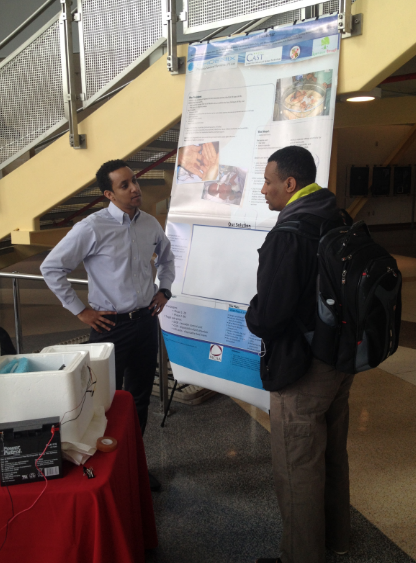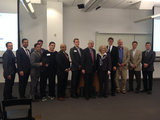by Sarah Hansen
Right: The winners and judges after the NCC-PDI conference and competition.
Govind Rao, UMBC Professor and Director of the Center for Advanced Sensor Technology (CAST), was the only attendee at the National Capital Consortium for Pediatric Device Innovation (NCC-PDI) to offer more than one presentation to the crowd of scientists, engineers, students, and entrepreneurs. The first focused on a disposable incubator project that the consortium funded last year. The second promoted a non-invasive respiration monitor for premature newborns, which was competing for funding among 12 finalists from 31 original applicants. University of Maryland–College Park hosted the event on February 12, 2015, and five of the finalists took home fat checks.
The National Capital Consortium for Pediatric Device Innovation is an FDA-funded consortium led by the Sheikh Zayed Institute for Pediatric Surgical Innovation at Children’s National Health System and the A. James Clark School of Engineering at the University of Maryland.
“What we’re trying to do is completely change the paradigm,” said Rao. The current standard practice for monitoring oxygen and carbon dioxide in babies uses a technique that requires heating the skin and often results in burns. An alternative technology requires drawing blood—a painful procedure that removes the precious red stuff from tiny neonates, who may only have a few teaspoons to begin with. Traditional methods also take several minutes to produce a reading, whereas Rao’s product only takes one. In clinical trials (on nine babies so far, and at least one dedicated graduate student) the results from the new device were just as accurate as established methods. Rao said, “Without doing any calibration or anything, it’s showing amazing correlation. Now the problem is how can I get this scaled up and out there.”

Dagmawi Tilahun, left, discusses CAST projects with a UMD-CP student at the conference. Tilahun is a UMBC alum who now works full-time at CAST.
Judges at competitions aren’t the only ones excited about the invention. “We showed this device off to doctors and nurses who had actually used the device that causes burns, and they were just amazed at the alternative,” said Rao. He has collaborations in the works with health organizations in Ethiopia, Nepal, the Philippines, and India.
At this point, the device is up and running but still physically a bit clunky. The lab will use the new funds to automate and miniaturize the monitor. That way, Madhubanti Chatterjee, whose PhD dissertation focused on developing the project, doesn’t have to hand-hold doctors as they use it. With a smile, Rao describes his plan to accomplish a compact design: “I’ve already lined up a [UMBC] computer science class where the teacher wants to help the students write apps, so I’ve got my student labor all set.”
Discounting cheap student labor, Rao still doesn’t expect the compact version to be expensive. “We’re leveraging all the cell phone technology, so it will actually be a very low-cost device.” Eventually, after miniaturization and further testing on babies, General Electric (GE) will take over manufacturing of the monitor.
The win for Rao and his team (GE and a team of physicians from the University of Maryland Medical School) at the NCC-PDI was especially sweet after missing out on funding at a similar competition in October 2014. After that letdown, Rao promised not to give up and encouraged his students, several of whom have spent countless hours developing the project, to do the same. Their hard work and dedication finally paid off. Perhaps a handheld, painless, non-invasive respiration monitor will be coming to a hospital near you someday soon.
For a story that describes more details of the device’s mechanism, click here.
A press release including the other grant winners can be found here.
Right: The winners and judges after the NCC-PDI conference and competition.
Govind Rao, UMBC Professor and Director of the Center for Advanced Sensor Technology (CAST), was the only attendee at the National Capital Consortium for Pediatric Device Innovation (NCC-PDI) to offer more than one presentation to the crowd of scientists, engineers, students, and entrepreneurs. The first focused on a disposable incubator project that the consortium funded last year. The second promoted a non-invasive respiration monitor for premature newborns, which was competing for funding among 12 finalists from 31 original applicants. University of Maryland–College Park hosted the event on February 12, 2015, and five of the finalists took home fat checks.
The National Capital Consortium for Pediatric Device Innovation is an FDA-funded consortium led by the Sheikh Zayed Institute for Pediatric Surgical Innovation at Children’s National Health System and the A. James Clark School of Engineering at the University of Maryland.
“What we’re trying to do is completely change the paradigm,” said Rao. The current standard practice for monitoring oxygen and carbon dioxide in babies uses a technique that requires heating the skin and often results in burns. An alternative technology requires drawing blood—a painful procedure that removes the precious red stuff from tiny neonates, who may only have a few teaspoons to begin with. Traditional methods also take several minutes to produce a reading, whereas Rao’s product only takes one. In clinical trials (on nine babies so far, and at least one dedicated graduate student) the results from the new device were just as accurate as established methods. Rao said, “Without doing any calibration or anything, it’s showing amazing correlation. Now the problem is how can I get this scaled up and out there.”
Dagmawi Tilahun, left, discusses CAST projects with a UMD-CP student at the conference. Tilahun is a UMBC alum who now works full-time at CAST.
Judges at competitions aren’t the only ones excited about the invention. “We showed this device off to doctors and nurses who had actually used the device that causes burns, and they were just amazed at the alternative,” said Rao. He has collaborations in the works with health organizations in Ethiopia, Nepal, the Philippines, and India.
At this point, the device is up and running but still physically a bit clunky. The lab will use the new funds to automate and miniaturize the monitor. That way, Madhubanti Chatterjee, whose PhD dissertation focused on developing the project, doesn’t have to hand-hold doctors as they use it. With a smile, Rao describes his plan to accomplish a compact design: “I’ve already lined up a [UMBC] computer science class where the teacher wants to help the students write apps, so I’ve got my student labor all set.”
Discounting cheap student labor, Rao still doesn’t expect the compact version to be expensive. “We’re leveraging all the cell phone technology, so it will actually be a very low-cost device.” Eventually, after miniaturization and further testing on babies, General Electric (GE) will take over manufacturing of the monitor.
The win for Rao and his team (GE and a team of physicians from the University of Maryland Medical School) at the NCC-PDI was especially sweet after missing out on funding at a similar competition in October 2014. After that letdown, Rao promised not to give up and encouraged his students, several of whom have spent countless hours developing the project, to do the same. Their hard work and dedication finally paid off. Perhaps a handheld, painless, non-invasive respiration monitor will be coming to a hospital near you someday soon.
For a story that describes more details of the device’s mechanism, click here.
A press release including the other grant winners can be found here.
Tags:
Posted: February 26, 2015, 7:03 PM
